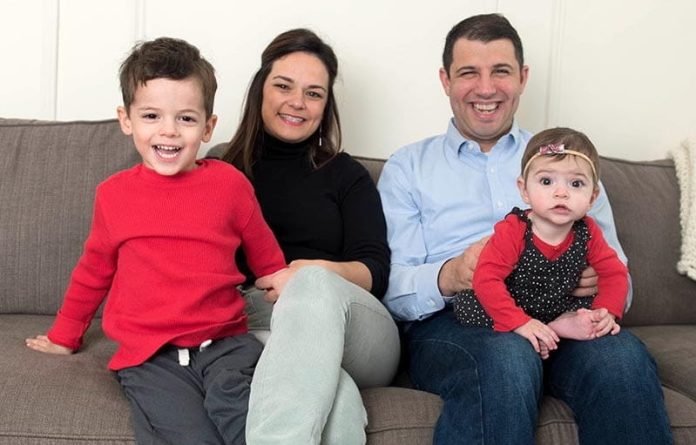
As she walked up to her fourth-floor apartment, Marisa MacDonnell figured something was different with this pregnancy, her second.
She felt winded. She had to take deeper breaths. And when she carried her then-2-year-old son, Sam, he felt heavier than his actual weight.
Even the activities she loved – walking and running – seemed more laborious.
She chalked it all up to working full-time and having an active toddler. The possibility that it was her heart didn’t cross her mind.
MacDonnell was born with a misconfigured aortic valve; instead of having three flaps (known as cusps), she was told she had two. She also had a narrowing of the aorta, which reduces blood flow.
However, she’d been living with those conditions since birth. Doctors always rated her condition as “stable to moderate,” with no limitations. She was even a competitive figure skater through high school.
There had been one red flag. At her annual checkup in 2014, MacDonnell’s cardiologist detected minor changes.
She told MacDonnell, then 28, that she would likely need a valve replacement, although probably not until her 50s or 60s.
In 2018, MacDonnell, who lives in Montclair, New Jersey, was cleared to get pregnant with her first child.
She gave birth to Sam naturally with no complications. In 2020, she and her husband, Brian Giardina, got the green light to have a second child.
That November, a 20-week ultrasound of the baby’s heart confirmed that all was well. The next month, MacDonnell had her regular cardiologist visit.
That night, her phone rang.
“The doctor needs you to come back in as soon as possible,” a nurse said.
The next day, the cardiologist told MacDonnell and Giardina that her condition had gone from moderate to severe.
She needed a valve replacement immediately, but doctors couldn’t perform the procedure while she was pregnant.
The cardiologist added that the pregnancy triggered the change. It stemmed from the increased blood volume in her body. There was no reason why it happened this time and not with her first pregnancy.
She saw a multitude of doctors, each seemingly with a different recommendation of what to do. They settled on a plan to induce labor at 36 weeks.
On Valentine’s Day 2021, MacDonnell – 31 weeks pregnant – was coloring with Sam. Bacon was cooking in the oven and Giardina was going to make waffles.
“I feel really weird,” MacDonnell said to Giardina. “There’s a strange sensation in my arms and hands and my chest feels heavy.”
He texted the cardiologist with her symptoms.
“Get to the hospital,” she texted back.
Giardina couldn’t go into the hospital because of COVID-19 protocols. He and Sam found a bakery to wait in. Eventually, they were told that MacDonnell would be held overnight for testing, so they went home.
MacDonnell’s electrocardiogram appeared normal. But a blood test showed a high level of troponin, often a sign of a heart attack.
After more testing, doctors confirmed she had a type of heart attack known as spontaneous coronary artery dissection, or SCAD. As the name suggests, it’s marked by a heart artery tearing without warning or reason.
Among the people who have SCAD, there’s a correlation to pregnancy, although it’s most common in the five months after delivery.
Doctors hoped the tear would repair itself. That meant MacDonnell would have to stay put.
“There was no way they were letting me go home until we had the baby,” MacDonnell said.
Giardina and MacDonnell’s mother, a nurse in Boston, were allowed to visit. But Sam, who was too young to be vaccinated against COVID-19, was not allowed in the hospital.
In March 2021, Giardina tested positive for COVID-19 10 days before the scheduled delivery, which meant he wasn’t allowed in the hospital for the birth.
Doctors decided that not only would MacDonnell need to deliver by cesarean section, but she would have to be fully anesthetized in case her valve needed to be replaced on the spot.
One of the doctors standing by in the room in case of an emergency texted Giardina almost immediately.
“Everything went great. It’s a girl!” he wrote. “And here’s the baby right after we pulled her out.”
He’d videotaped the birth on his phone.
“I was devastated to miss it, but ecstatic to see it,” Giardina said.
MacDonnell met their daughter, Cecilia, or Cece, 12 hours after she was born. Cece even beat her mother home by a day.
Better still, tests showed that her heart is normal. Sam’s, too.
In November 2021, MacDonnell underwent open-heart surgery. Doctors replaced her diseased aortic valve with her own pulmonary valve, and then implanted a donor pulmonary valve.
Upon closer inspection of her faulty valve, doctors discovered that her aorta wasn’t missing one flap – it was missing two. Thus, she had one flap instead of the usual three.
“They said I should have had it replaced a long time ago,” MacDonnell said.
Now, a year later, MacDonnell is back to running and living a normal life. She has more energy than ever, a byproduct of having a fully functioning heart for the first time.
“There’s a chance that something might need to be adjusted or fixed in the future,” MacDonnell said. “But I’m optimistic that there will be a solution in the future. The science advances all the time.”
Written by Diane Daniel.
If you care about heart health, please read studies about how eating eggs can help reduce heart disease risk, and herbal supplements could harm your heart rhythm.
For more information about health, please see recent studies that olive oil may help you live longer, and vitamin D could help lower the risk of autoimmune diseases.



